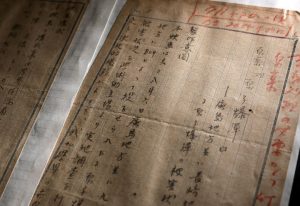Documenting Hiroshima of 1945: Late September, aiming at production of scientific and technical documentary film depicting damages from A-bombing
Sep. 27, 2024
by Kyosuke Mizukawa, Senior Staff Writer
In late September 1945, Nippon Eigasha (Japan Movie Co.), a film production company based in Tokyo, sent a succession of staff members to Hiroshima City with the aim of producing a documentary film depicting the devastation from the atomic bombing. Under government controls put in place on film production, Nippon Eigasha was established in 1941 after consolidation of news film divisions of newspapers and news agencies as well as cultural film departments of film production companies. Even after the war, the company continued to produce news footage, including the filming of a visit to Hiroshima on September 3 by Chamberlain Torahiko Nagazumi, who had been sent to the city by Japan’s Emperor Showa.
At the beginning of September, Nippon Eigasha made the determination internally to produce a documentary film depicting the devastation caused by the atomic bombing. The film’s original production proposal, left behind by Hidetsugu Aihara — one of those involved in the film plan from its inception whose original first name was Shuji and who died in 2008 at the age of 98 — is now held at the Hiroshima Peace Memorial Museum.
The proposal emphasized that the film would serve as a “report in film form” to the world through its depiction of the A-bombing devastation from a scientific and technical perspective. The proposal described the film’s contents as “empirically clarifying whether the atomic bomb was used as a tool of strategic bombing or as an inhumane tool that exceeded those limits.”
Mr. Aihara asked Yoshio Nishina, an atomic physicist who had come to Hiroshima on August 8 for the conduct of a survey of the situation, to oversee and edit the film. When a Japanese Ministry of Education research council formed a special task force for investigation of destruction from the atomic bombing on September 14, Nippon Eigasha was placed in the position of a support organization for the task force in charge of film production.
Announcing it would conduct comprehensive research on damages from the atomic bombing, the task force planned a survey involving around 200 people from universities and research institutes. Accordingly, nine subcommittees were established, including those on physics, chemistry, and geography; biology; civil engineering and architecture; and medicine, among others. To align itself generally with those subcommittees, Nippon Eigasha formed five film teams — biology, physics, civil engineering and architecture, medicine, and news/miscellaneous support, made up of around a total of 30 staff members, including photographers charged with the work of taking still photographs.
Of the five film teams, the biology contingent left Tokyo first, arriving in Hiroshima City on September 21. By the end of that month, members of the physics and medicine teams had arrived in succession to the city.
(Originally published on September 27, 2024)
In late September 1945, Nippon Eigasha (Japan Movie Co.), a film production company based in Tokyo, sent a succession of staff members to Hiroshima City with the aim of producing a documentary film depicting the devastation from the atomic bombing. Under government controls put in place on film production, Nippon Eigasha was established in 1941 after consolidation of news film divisions of newspapers and news agencies as well as cultural film departments of film production companies. Even after the war, the company continued to produce news footage, including the filming of a visit to Hiroshima on September 3 by Chamberlain Torahiko Nagazumi, who had been sent to the city by Japan’s Emperor Showa.
At the beginning of September, Nippon Eigasha made the determination internally to produce a documentary film depicting the devastation caused by the atomic bombing. The film’s original production proposal, left behind by Hidetsugu Aihara — one of those involved in the film plan from its inception whose original first name was Shuji and who died in 2008 at the age of 98 — is now held at the Hiroshima Peace Memorial Museum.
The proposal emphasized that the film would serve as a “report in film form” to the world through its depiction of the A-bombing devastation from a scientific and technical perspective. The proposal described the film’s contents as “empirically clarifying whether the atomic bomb was used as a tool of strategic bombing or as an inhumane tool that exceeded those limits.”
Mr. Aihara asked Yoshio Nishina, an atomic physicist who had come to Hiroshima on August 8 for the conduct of a survey of the situation, to oversee and edit the film. When a Japanese Ministry of Education research council formed a special task force for investigation of destruction from the atomic bombing on September 14, Nippon Eigasha was placed in the position of a support organization for the task force in charge of film production.
Announcing it would conduct comprehensive research on damages from the atomic bombing, the task force planned a survey involving around 200 people from universities and research institutes. Accordingly, nine subcommittees were established, including those on physics, chemistry, and geography; biology; civil engineering and architecture; and medicine, among others. To align itself generally with those subcommittees, Nippon Eigasha formed five film teams — biology, physics, civil engineering and architecture, medicine, and news/miscellaneous support, made up of around a total of 30 staff members, including photographers charged with the work of taking still photographs.
Of the five film teams, the biology contingent left Tokyo first, arriving in Hiroshima City on September 21. By the end of that month, members of the physics and medicine teams had arrived in succession to the city.
(Originally published on September 27, 2024)








